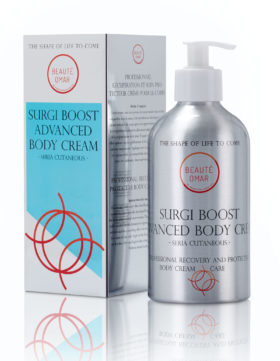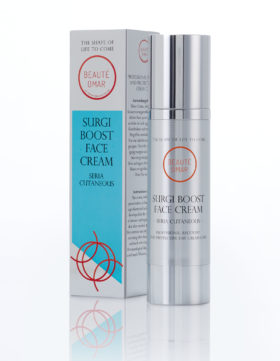Recently, more and more has been written about peptides in cosmetics. But what exactly are they and what can they do? Peptides are contained in the Seria Cutanoues products and are responsible for the booster effect, among other things. There are different types of peptides. In Seria Cutaneous, a specific peptide complex is used in the certified creams, which is similar to a bio-placenta. What is so special about it and why it behaves this way, you will learn in the following lines.
Peptides as essential growth factors
After birth and into adolescence, the body produces its own growth factors. These are essential for the development of connective and supporting tissue, such as skin and bones. With increasing age, the production of growth factors declines rapidly and from the age of 18 is only minimally endogenous, i.e. produced by your body itself.
Peptides are a type of protein consisting of short chains of amino acids. The peptide complex used for Seria Cutaneous is equivalent to a bio-placenta, as it is made up of five different peptides that are considered essential growth factors. These are highly effective, as the concentration of these peptides in active cosmetics is particularly high. They are above 3% in order to be able to effectively trigger an effect on the skin’s appearance.
Synthetic production of essential growth factors
Nowadays, these essential growth factors can be produced in the laboratory by fermentation processes. Five different essential growth factors are produced that correspond to a bio-placenta. These are, for example, EGF or IGF-1, which in turn stimulate the fibroblasts to become active.
Peptide complex: proven in its mode of action in wound healing
The activation of the fibroblasts by the peptides leads to the formation of new collagen and elastin. This is shown, for example, when used in wound healing and a rapid re-epithelialisation of the wound surface is observed. Further microscopic examinations and laboratory tests, such as the Western blot, show a densification and increase of procollagen type 1.
This effect is therefore not only useful for supporting the healing of the skin after medical interventions, but also shows a very good anti-ageing effect. The skin not only looks healthier, but also firmer and smoother. Read more in the following paragraph.
The BEAUTÉ Booster: What makes peptides ideal for use in cosmetics?
As an external application, it manifests itself in a noticeably even complexion, well-hydrated skin, as well as fewer pigmentation spots and the smoothing of fine wrinkles.
Peptides thus have their specific properties that make them ideal for cosmetics – especially for those who strive for a youthful, fresh appearance and a healthy complexion. However, peptides can do even more. Not only do they have a powerful effect on the appearance of the skin, they can also help to slow down the ageing process of the skin.
They help reduce fine lines and wrinkles by increasing cellular metabolism. This slows down with age. Less collagen and elastin is produced. The skin loses tone and elasticity. It not only becomes drier, but also increasingly thinner. Sebum production, which keeps the skin supple, also slows down. The peptide complex counteracts this by stimulating the cell metabolism of the fibroblasts. The production of collagen and elastin increases again, tone and elasticity increase. As essential growth factors, they support cell renewal and can also repair damaged skin. This effect is particularly helpful for ageing skin, cortisone skin or the so-called parchment skin.
Inflammatory processes, such as those of neurodermatitis, are usually treated with creams containing cortisone. Cortisone has the property of slowing down inflammatory processes. As a drug, however, it also has side effects, such as causing very thin skin (also called cortisone skin or parchment skin). The peptides also have the property of alleviating inflammatory processes and thus they are also effective in the care of atopic dermatitis damaged skin. However, without the negative effect of thin parchment skin.
Injured skin, such as after minor injuries or after an operation (such as a laser treatment or liposuction) benefits from these properties!
How safe are peptides in cosmetics?
Peptides are not only very effective in the cosmetics industry, but also very safe. They do not contain synthetic ingredients or synthetic dyes, so they are suitable for all skin types. They have no side effects and can be used for long periods of time. Here is a summary of how peptides work:
|
Growth process |
Effect in the tissue |
Visible signs |
|
Firm smooth skin texture, reduction of fine wrinkles |
Peptides stimulate collagen and elastin production |
which tightens the complexion and smoothes wrinkles |
|
Reduction of pigmentation spots |
Regulation of melanin production |
make the skin appear more even |
|
Hydration of the skin |
Bind and store moisture |
Skin shows a fresh GLOW |
|
Repair of injured or inflamed tissue such as neurodermatitis or cortisone skin |
Stimulation of fibroblasts, re-epithelialisation, alleviation of inflammatory processes in the skin. |
Improved tissue structure in the healing of inflamed skin or in wound healing, cortisone skin. |
Peptides can be an effective solution to reduce premature signs of ageing and make the complexion appear firmer. They stimulate collagen production, reduce pigmentation spots and hydrate the skin down to the deep layers. They also provide optimal care for skin problems such as neurodermatitis, dry skin or cortisone skin.
Is the use of peptides suitable for every skin type?
Peptides can be used without hesitation for any skin type. No negative properties are known so far. Since it is a cosmetic product, the concentration is chosen in such a way that although an effect can be proven in studies, with the dose limitation it is not equivalent to a drug with side effects.
The organic placentas contained in the Seria Cutaneous products are based on years of research and development. They are subject to various certifications. Because of this controlled production, this active ingredient is also safe to use in cosmetics.
Why use the advantages of active ingredient cosmetics with a booster effect through peptides in skin care?
BEAUTÉ OMAR stands for active ingredient cosmetics of the new generation. The Seria Cutaneous uses the advantages that active ingredients can deliver. The booster effect is shown by the turn-over of the skin after regular use. This is due to the highly efficient peptide complex and the other natural and active high-quality ingredients.
True to the credo “Nature meets Science”: natural ingredients and active ingredients in the respective high concentration support intensive and lasting care.
And that is what this skin care is all about. To care for the skin sustainably so that a healthy complexion and a radiant glow are revealed. Of course, the signs of skin ageing should be delayed, so it is all the more important to use care that also reaches the deep layers of the skin. The certified creams of the Seria Cutaneous, such as the Surgi Boost Face Cream and the Surgi Boost Advanced Body Cream, have been specially developed for you to meet these demands.
References:
1. Chemistry and biology of hyaluronan, Har G.Garg, Charles A. Halles, Elsevier,
2. Journal of Cell Science 116, 3227-3248
3. Placental growth factors, BV Rama Sastry, Placental pharmacology p. 126-150
More about Beauty & Care at BEAUTÉ OMAR
If this magazine article has aroused your interest in the products and philosophy of BEAUTÉ Omar, then feel free to browse further:






